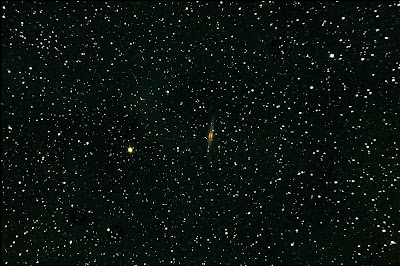Still, I was able to capture some reasonably good images over the past three months. Here are some examples.
M45
The famed Pleiades (M45) which appear so conspicuously in the Fall and Winter skies. My previous cameras didn't have large enough CCD chips to capture the entire cluster at once.
 This image was taken on August 24, and is composed of 14, 300-second sub-exposures, for a total exposure time of 70 minutes.
This image was taken on August 24, and is composed of 14, 300-second sub-exposures, for a total exposure time of 70 minutes.NGC 281
Sometimes referred to as the "Pac Man Nebula," this is a fairly bright emission nebula in Cassiopeia.
 This image combines data obtained on August 22 & 24. Thirteen, 300-second subexposures were combined for a total exposure time of 65 minutes. The image has been cropped to highlight the nebula itself.
This image combines data obtained on August 22 & 24. Thirteen, 300-second subexposures were combined for a total exposure time of 65 minutes. The image has been cropped to highlight the nebula itself.
M103
One of Cassiopeia's many open star clusters, M103 appears as an tight-knit arrow-shaped group of stars in a particularly rich starfield.
 This image was taken on August 22 and comprises six, 150-second sub-exposures for a total exposure time of 15 minutes.
This image was taken on August 22 and comprises six, 150-second sub-exposures for a total exposure time of 15 minutes.NGC 7635
The Bubble Nebula is another one of Cassiopeia's many treasures. This an emission nebula whose eponymous "Bubble" is the result of stellar winds from a hot, young star colliding with the nebula's gas.

This image comprises data from the nights of June 27, August 7, and August 22, and has been cropped to highlight the nebula. Twelve, 300-second sub-exposures were combined to create this image, totaling one hour of total exposure time.
NGC 7635 & Friends

This image, taken on August 22, shows NGC 7635 in its rich starfield. The camera's large chip and LXD-75's wide field of view not only captures the Bubble Nebula, but the open cluster M52 (at the top left) and the small emission nebula NGC 7538 (lower right corner).
NGC 891
This is a spiral galaxy seen edge-on in Pegasus.

NGC 6946 & NGC 6939
One of the relatively few galaxies visible in the summer sky, NGC 6946 is a spectacular spiral seen face on through the dense starfields of Cepheus. The galaxy appears close by to an open cluster, NGC 6939. Of course, the galaxy is about 10 million light years away, outside our galaxy, whilst the cluster is thousands of light years away and well within the Milky Way.

This image is compose of just five, 300-second sub-exposures, for a total of only 25 minutes. I had planned to go back and accumulate several hours of imaging data to truly bring out the galaxy's spiral arms, but alas, the weather did not permit this. NGC 6946 is therefore high on the list for next summer's imaging.
NGC 884 & 869
An early taste of the Fall sky comes as Perseus begins to rise after midnight. The famous double cluster is two young star clusters (less than six million years old) that are withing a 1000 light years of each other. The effect is simply beautiful.

This image comprises eight, 300-second sub-exposures for a total exposure time of 40 minutes.
IC 5146
The Coccoon Nebula in Cygnus is in fact a combination of star cluster and nebula appearing in a very rich star field.

No comments:
Post a Comment